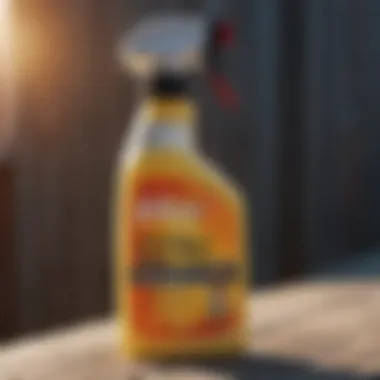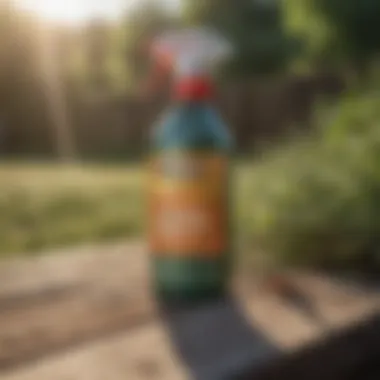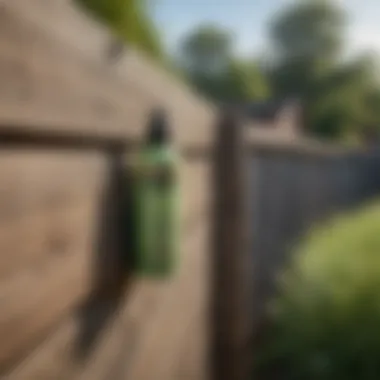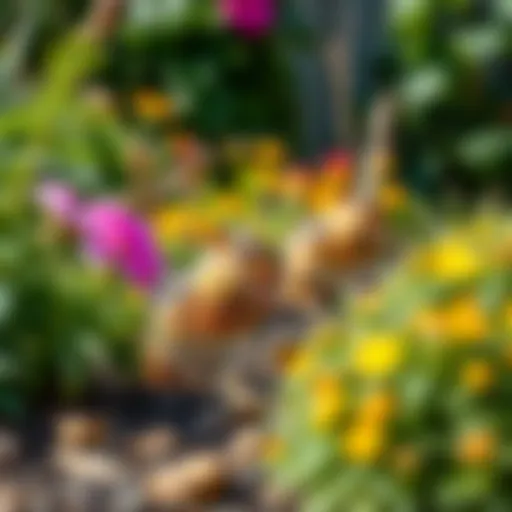D Fence Bug Spray: An In-Depth Analysis of Effectiveness


Intro
D Fence bug spray has gained attention for its potential in pest control. With rising interests in eco-friendly solutions, understanding how this product works and its active ingredients is crucial. In this examination, we will explore what makes D Fence a remarkable option in managing pests, focusing on its formulation, effectiveness, and applications.
Understanding Pests
Definition of Pests
Pests are organisms that can cause harm to human health, plants, or property. They can include insects, rodents, fungi, and weeds. Often, pests are categorized based on the damage they cause. For instance, mosquitoes and cockroaches are considered nuisances due to their potential health risks, while aphids and termites directly affect plants and structures.
Importance of Pest Identification
Identifying the specific type of pest is essential for effective control strategies. Different pests require different approaches. Knowing what you are dealing with informs your choice of products and methods. For example, D Fence bug spray may work wonders against common house insects, but it might not be suitable for larger pests or outdoor infestations.
Prevention Techniques
Home and Garden Preventative Measures
Maintaining a pest-free environment starts at home. Simple changes can drastically reduce pest populations:
- Keeping food sealed and stored properly to avoid attracting insects.
- Regularly cleaning areas where food is prepared and consumed.
- Sealing cracks and crevices around windows and doors to block potential entry points.
In gardens, proper maintenance is key. Regularly inspect plants, and remove any debris which can harbor pests.
Seasonal Prevention Tips
Each season brings unique challenges:
- In spring, check for signs of emerging destructive insects.
- During summer, monitor for increased pest activity in warmer temperatures.
- Fall is the time to prepare for winter by sealing entry points before pests seek shelter.
- Winter should focus on exterior checks; pests can damage structures even in colder months.
Eco-Friendly Pest Control Solutions
Overview of Sustainable Practices
There is a growing need for sustainable pest control methods. Eco-friendly solutions minimize harm to the environment and maintain ecological balance. D Fence bug spray supports these principles by using ingredients designed to effectively reduce pest populations while posing less risk to non-target organisms and the ecosystem.
Natural Remedies and Their Effectiveness
Many homeowners opt for natural remedies alongside chemical treatments. Some common options include:
- Diatomaceous earth: A powder that can kill insects upon contact by drying them out.
- Essential oils: Oils like peppermint and tea tree have been found effective against certain pests.
- Soap sprays: Mild soap can suffocate pests like aphids and spider mites.
The effectiveness of these alternatives varies, and careful application is required to achieve desired results.
"Understanding pests and utilizing the right methods is the foundation of effective management."
By examining D Fence bug spray alongside these integrated pest management strategies, we can approach pest control holistically. This ensures methods used remain efficient while considering health and environmental safety. The following sections will further explore the specific aspects of D Fence and its application.
Preamble to Fence Bug Spray
The discussion surrounding D Fence bug spray serves as an important exploration into its practical application and effectiveness in pest control. Understanding this product allows householders and mothers to make informed choices regarding pest management in their environments.
Pest control is a significant consideration for many, especially in residential areas. Bugs and insects not only pose a nuisance but can also threaten health and property. Therefore, an effective solution like D Fence becomes essential. This section outlines what D Fence bug spray is, its intended purposes, and how it stands as a useful tool in managing unwanted pests.
Definition and Purpose
D Fence bug spray is a pesticide formulated to eliminate a variety of insects that invade homes and gardens. Its purpose is primarily to control pest populations in an effective and efficient manner. This formulation is there to act as a barrier against pests, offering protection to your living space.
The active ingredients typically include several substances that target specific types of insects. Many users appreciate its ability to not only kill but also repel further infestations. Clearly, the main objective of using this product is to provide a safe and pest-free environment. However, one must also consider using it responsibly and as per recommendations to avoid negative outcomes.
Common Uses in Pest Control
D Fence bug spray has several common uses in pest control. Most frequently, it is employed to battle insects such as ants, roaches, and mosquitoes. Each of these pests not only disturbs daily life but can also affect health.


Here are a few common applications:
- Indoor Use: Homeowners commonly spray D Fence in their kitchens or living areas to target household pests. Its effectiveness in these spaces contributes to a more comfortable and hygienic atmosphere.
- Outdoor Application: Gardens and yards are other areas where D Fence is often applied. Here, it prevents pests from damaging plants, providing a protective shield to maintain the beauty of outdoor spaces.
- Perimeter Treatment: Many users apply D Fence around the perimeter of their homes, acting as a barrier to deter insects from entering.
In summary, D Fence bug spray is a versatile tool in pest management that applies not only in homes but also around outdoor spaces. By understanding its definition and common uses, householders can make educated decisions about pest control methods.
Chemical Composition of Fence Bug Spray
Understanding the chemical composition of D Fence Bug Spray is crucial for multiple reasons. It directly influences the product's effectiveness in pest control while also affecting environmental impact and user safety. Each component plays a role in determining how well this spray works against various pests. Moreover, knowing the composition helps users make informed decisions, especially those who value eco-friendly practices and health considerations.
Active Ingredients
Active ingredients in D Fence Bug Spray are responsible for its pest-fighting capability. These ingredients are effective at targeting specific insects, reducing their populations in treated areas. Common active ingredients found in this spray may include Pyrethroids, which are synthetic chemicals that mimic natural insecticides derived from chrysanthemum flowers. Another ingredient often included is imidacloprid, a neonicotinoid that disrupts the nervous system of pests. Understanding these components can help homeowners select the best spray for their specific pest problems.
- Pyrethroids: Known for rapid knockdown effects and broad-spectrum activity.
- Imidacloprid: Targets pest nervous systems, particularly effective against ants and termites.
- Other Ingredients: Depending on the formulation, other agents may enhance performance or act as solvents and carriers.
Proper comprehension of these ingredients is vital. It indicates how the product interacts with the intended pests and the environment.
Synergistic Effects of Ingredients
The interaction between different ingredients in D Fence Bug Spray can create synergistic effects, enhancing overall effectiveness. When two chemicals work together, their combined effect can be greater than the sum of their individual effects. For instance, Pyrethroids may work more effectively when combined with a small amount of other insecticides that target different pathways in a pest's biology. This can lead to quicker results and greater pest control efficacy.
Understanding these synergistic effects is essential, especially for homeowners looking for powerful solutions.
- Enhanced Efficacy: Combinations can lead to faster knockdowns and reduced chances of pest resistance.
- Targeting Multiple Pests: Synergistic formulations can tackle a wider range of insects, addressing diverse pest issues in a single application.
- Reduced Chemical Load: Using synergy can sometimes mean lower concentrations of each ingredient, minimizing potential environmental impact.
Overall, grasping the chemical composition of D Fence Bug Spray, including both the active ingredients and their synergistic effects, equips users with greater knowledge. This knowledge enables them to maximize the benefits of this pest control solution while maintaining responsible practices.
Effectiveness of Fence Bug Spray
The effectiveness of D Fence bug spray is a central theme in understanding its role in pest control. Knowing how well this product performs against various pests is crucial for users who seek reliable solutions in managing unwanted infestations. Effectiveness can be typically measured in terms of its ability to target specific pests, the duration of its impact, and its overall performance compared to similar products.
Target Pests
D Fence bug spray is particularly effective against a variety of pests that commonly invade homes and gardens. Some of the main target pests include:
- Ants: These can be disruptive, especially when they create colonies indoors. D Fence is formulated to eliminate them quickly.
- Roaches: Known for their resilience, cockroaches pose health risks. This spray acts swiftly to tackle these unwanted invaders.
- Mosquitoes: These pests not just irritate but can also transmit diseases. D Fence provides a protective barrier.
- Flies: Whether houseflies or fruit flies, they can contaminate food and surfaces. The product helps in managing these annoyances effectively.
This broad spectrum of target pests makes D Fence a versatile choice for homeowners. Users can confidently rely on this product for various common infestations, reducing the need for multiple products.
Comparison with Alternative Products
When discussing the effectiveness of D Fence bug spray, it is also relevant to compare it to alternative products on the market. Some consumers may wonder how well it stacks up against others, such as Ortho Home Defense or Raid. Here are some points of comparison:
- Active Ingredients: Many alternatives use similar active ingredients, but the concentration and formulation of D Fence can lead to improved efficacy in elimination.
- Residual Effect: D Fence tends to provide a longer-lasting protective effect, which is often a concern for users who want ongoing pest control.
- Ease of Use: The spray mechanism of D Fence is generally considered user-friendly, allowing for efficient application compared to bulkier alternatives.
In truth, the choice of bug spray often comes down to personal preference and specific needs. However, many users report satisfaction with D Fence, noting it is both effective and easy to apply.
"The effectiveness of D Fence spray has made it my go-to choice for pest control in and around my home. It keeps the bugs out for weeks with just one application."
— A satisfied user
Understanding the effectiveness of D Fence bug spray starts with recognizing its direct impact on target pests and its relative performance compared to alternatives. This comprehensive view can help homeowners make informed decisions for pest management.
Application Guidelines
The section on Application Guidelines is crucial for users of D Fence Bug Spray, as it provides essential information on how to maximize its effectiveness while ensuring safety. Proper application can mean the difference between successful pest control and potential hazards. Understanding how to prepare for use, employ effective techniques, and implement safety measures creates a comprehensive strategy for managing unwanted insects.
Preparation for Use
Before using D Fence Bug Spray, preparing adequately is vital. First, read the label carefully to understand the specific usage instructions and any precautions. This labeling often contains information regarding dilution ratios, application environments, and suggested frequency of use.
Next, gather your materials. You will need:
- Protective clothing, including gloves and masks
- A spray applicator, which can range from handheld to professional equipment
- A clean container for preparing the spray, if dilution is necessary
- An area map to note where you plan to apply the product


Preparing the area for treatment is also important. Remove any food items, toys, or valuables from the vicinity of application to avoid contamination. If applicable, ensure pets and children are kept at a safe distance. Taking these steps makes sure the environment is safe and allows for a more targeted application of the spray.
Application Techniques
Effective application of D Fence Bug Spray requires appropriate techniques to ensure even coverage and penetration. Here are some recommended methods:
- Spray Distance: Maintain a distance of around 12-18 inches from the surface you are treating. This helps achieve an even coating without excess runoff.
- Even Motion: Use a sweeping motion while spraying to ensure that all areas receive treatment. This method helps in reaching cracks and crevices where pests often reside.
- Multiple Layers: In situations of heavy infestation, consider applying multiple thin coats instead of one heavy coat. This approach prevents pooling of the product and enhances effectiveness.
- Target Areas: Focus on areas known for pest activity, such as corners, entry points, and other hiding spots. Thoroughly treat these zones to cut off pathways for the insects.
Safety Measures
Ensuring safety during the use of D Fence Bug Spray cannot be overstated. Here are some key safety measures:
- Personal Protective Equipment (PPE): Always wear gloves, long sleeves, and a mask to protect against inhalation and skin exposure.
- Ventilation: When using the spray indoors, open windows and doors for adequate ventilation. This helps disperse any fumes that may be harmful.
- Storage: Store the spray in a cool, dry place away from sunlight and out of reach of children and pets. Proper storage helps maintain the integrity of the product while ensuring safety.
- Emergency Procedures: Familiarize yourself with emergency procedures in case of accidental exposure. Know who to contact and what steps to follow.
Ensuring that you follow these application guidelines makes using D Fence Bug Spray effective and safe. These practices may save not only your home environment but also potentially prevent personal harm.
By understanding these application guidelines, users can effectively reduce pest populations while increasing the safety and health of their living spaces.
Environmental Impact of Fence Bug Spray
Understanding the environmental impact of D Fence Bug Spray is essential for informed use in pest control. This section will delve into key areas of concern associated with its application. Awareness of environmental effects helps users minimize potential harm to ecosystems while managing pest populations effectively.
Toxicity to Non-target Species
One primary consideration when using D Fence Bug Spray is its toxicity to non-target species. Non-target species refer to living organisms that are not intended to be affected by the application. These may include beneficial insects like bees and butterflies, as well as pets and other wildlife. Research indicates that some active ingredients in pest control, identical or similar to those in D Fence Bug Spray, can interfere with the behavior and survival of non-target species.
For instance, studies have shown that certain components of insecticides can disrupt the hormonal systems of beneficial insects. This can lead to population declines, which in turn affect pollination and the broader ecological balance. Therefore, users should consider applying D Fence Bug Spray during times when non-target species are least active, such as early morning or late evening, to reduce unintended exposure.
Breakdown and Residual Effects
Another important aspect is how D Fence Bug Spray breaks down in the environment and its residual effects. After application, the spray does not immediately vanish; rather, it can persist in the environment for various lengths of time depending on conditions. Factors such as temperature, humidity, and sunlight can influence the degradation of its ingredients.
Some active ingredients may degrade quickly, becoming harmless within days, while others may linger for weeks or even months. This residual effect raises concerns about runoff into water bodies, which can threaten aquatic life and disrupt local ecosystems.
"Understanding the breakdown of chemicals used in pest control is vital for evaluating potential long-term impacts on the environment."
Regulatory Considerations
It is crucial to understand the regulatory environment surrounding D Fence bug spray for several reasons. First, these regulations ensure that the products used in pest control are safe for both users and the environment. The rigor of these regulations provides a framework that protects consumers from ineffective or harmful substances.
Furthermore, compliance with these regulations is important for manufacturers and sellers. It establishes credibility in the marketplace and helps avoid potential legal issues. Regulations also foster the responsible use of pest control products, promoting sustainable practices that minimize environmental harm. The responsibilities of manufacturers extend beyond mere compliance; they must ensure their products deliver on their promises while adhering to safety standards.
Regulations Governing Use
The authorities that govern pesticide usage often include national and regional agencies. For instance, in the United States, the Environmental Protection Agency (EPA) plays a significant role in regulating the use of pesticides, including bug sprays like D Fence. The EPA reviews product formulations, assesses potential risks, and ensures that labels meet strict adherence guidelines. As a result, consumers can have confidence in the safety and efficacy of the items they choose for pest control.
Regulations generally address the following aspects:
- Approval for use: Before any pest control product comes to market, it must undergo rigorous testing to prove its safety and effectiveness.
- Application limits: Specific instructions on how and when to apply the product are enforced to prevent misuse.
- Storage and disposal: These regulations ascertain that residual chemicals do not adversely affect the environment post-application.
Labeling and Safety Data Sheets
Labeling is a critical part of any pest control product, functioning to inform users how to safely and effectively use D Fence bug spray. The label must provide clear instructions, including:
- Active ingredients: Listing these allows users to understand what they are applying, addressing concerns about allergies or sensitivities.
- Application methods: Informing users of the best practices ensures optimal results and prevents misuse.
- Safety precautions: Specific guidelines help users protect themselves during application and minimize risk to non-target species.
Safety Data Sheets (SDS) complement product labeling by providing in-depth details on usage, handling, and emergency measures. They serve as an essential resource for both consumers and pest control professionals alike. Proper understanding of the SDS can safeguard against accidental exposure and inform users of potential hazards associated with the product.
Understanding regulatory compliance and product labeling is critical for ensuring safe and effective pest management.
In summary, navigating the regulatory landscape regarding D Fence bug spray is indispensable for users who prioritize safety and efficiency in pest control. Awareness of the regulations and labeling information enhances informed choices, resulting in responsible usage that benefits both consumers and the environment.
User Experiences and Testimonials


User experiences and testimonials play a significant role in understanding the real-world effectiveness of D Fence bug spray. Feedback from actual users provides valuable insights that go beyond the technical specifications found in product descriptions. It helps potential buyers make informed choices and showcases the range of situations where the spray has been used. By examining both positive outcomes and common complaints, we can paint a well-rounded picture of this pest control product.
Positive Outcomes
Users of D Fence often share their satisfaction through positive testimonials. Many report immediate effectiveness against various pests, which makes it a reliable solution for urgent infestations. For example, numerous house owners highlight its efficacy in managing household pests such as ants and roaches, praising how quickly they noticed a decrease in pest activity.
Some other positive aspects noted by users include:
- Ease of application: Many users find the spray easy to handle and apply in both indoor and outdoor settings.
- Long-lasting effects: Several testimonials mention the residual effectiveness of the spray, with users observing a prolonged period without pest sightings.
- Safe for use around pets: Pet owners express relief knowing that when used according to instructions, D Fence does not harm their animals.
These benefits not only enhance the product’s appeal but also contribute to its popularity among homeowners seeking effective pest control without excessive chemical exposure.
Common Complaints
Despite the positive feedback, some users have experienced issues with D Fence bug spray. Understanding these complaints provides context and balance.
Some common complaints include:
- Strong odor: A number of users have reported a potent smell that can be off-putting, particularly for those with sensitivities.
- Limited effectiveness on specific pests: While many found success with common household pests, some users noted that D Fence was less effective against more resistant species, such as bedbugs or specific types of spiders.
- Application challenges: A few users have had difficulties with spray dispersion, expressing concern about uneven coverage or clogging, leading to less efficient pest control.
Overall, these complaints highlight the importance of careful application and understanding one's specific pest problems before selecting a treatment.
"User testimonies remind us that while products may be effective, experiences can vary. Investigating both successes and setbacks leads to better pest management choices."
When evaluating D Fence bug spray, user experiences offer deeper insights. They reinforce the idea that what works in theory may not always align with practice, encouraging potential users to think critically.
Readers can further explore user discussions on platforms like reddit.com for a range of opinions and shared experiences.
Alternative Pest Control Approaches
In the quest for effective pest management, exploring alternative approaches becomes essential. Traditional pesticide use can sometimes raise concerns about both health and environmental impacts. Therefore, it is valuable to consider alternative methods that can provide effective pest control while minimizing these risks. This section outlines two significant categories of alternatives: natural pest control methods and chemical substitutes.
Natural Pest Control Methods
Natural pest control methods utilize various biological and ecological strategies to manage pest populations without synthetic chemicals. Such approaches rely on the natural predators of specific pests, enhancing the ecosystem's balance.
- Beneficial Insects: Introducing insects like ladybugs or lacewings can suppress aphid populations. These beneficial species feed on harmful pests, thus reducing their numbers.
- Companion Planting: Some plants can deter pests when grown alongside crops. For instance, marigolds are known to repel nematodes and aphids, contributing to better crop health.
- Biological Insecticides: Products derived from natural sources, such as Bacillus thuringiensis (Bt), target specific larvae and are safer for humans and non-target species.
These strategies not only reduce reliance on synthetic chemicals but also promote a healthier environment for both humans and wildlife.
Chemical Alternatives
While some people prefer non-chemical methods, certain situations may still call for chemical alternatives that are considered less harmful than traditional options. Here, we can explore some examples:
- Low-Toxicity Pesticides: Products with lower toxicity levels, such as insecticidal soaps or diatomaceous earth, can be effective while posing lesser risks.
- Target-Specific Formulations: Some chemical products are designed to target only specific pests, thereby limiting their impact on other beneficial organisms.
- Organic Approved Chemicals: Using substances like neem oil or pyrethrins, which have organic certification, can effectively control pests while adhering to organic gardening principles.
Adopting these chemical alternatives can provide a middle ground for those seeking effective pest control without fully resorting to conventional pesticides.
Considering the potential implications on health and the environment, exploring alternative pest control methods seems not only prudent but necessary for sustainable practices in pest management.
The Future of Bug Spray Technology
The evolving landscape of pest control reveals critical advances in bug spray technology. Innovations are not only enhancing efficacy but also aligning with growing ecological concerns. Understanding these advancements is essential for homeowners and professionals alike. As consumers become more conscious about the products they use, the demand for safe and effective pest control solutions increases. This section explores current trends and future directions of bug spray technology, addressing both benefits and considerations that shape this industry.
Innovations in Pest Management
Recent years have witnessed significant developments in pest management approaches. D Fence Bug Spray reflects these changes by incorporating various methodologies designed to optimize effectiveness while minimizing risk. Key innovations include:
- Biotechnology Integration: Researchers are employing biotechnologies, such as genetically modified organisms, to target pests more effectively. This can lead to products that are less harmful to non-target species.
- Smart Pesticides: Technology is allowing for the creation of smart pesticides, which are designed to release active ingredients only under specific conditions. This targeted application reduces environmental impact and improves safety.
- Eco-friendly Formulations: There is a marked shift toward natural ingredients. These formulations aim to repel or kill pests without leaving harmful residues. They provide homeowners peace of mind, knowing they are using less toxic solutions.
Such innovations represent a significant progression from traditional methods. The focus is shifting toward sustainable solutions that meet efficacy and safety criteria.
Sustainability Challenges
While advancements in bug spray technology are promising, there are notable sustainability challenges that need addressing. A few factors complicate the landscape of eco-friendly pest control:
- Cost Implications: Developing new technologies and improving existing formulations often incurs higher costs. These expenses may be passed on to consumers, making eco-friendly options more dissuasive for some homeowners.
- Regulatory Hurdles: Adhering to changing regulations can limit the speed at which new products reach the market. Innovations must comply with safety standards set by various governing bodies, which can delay their availability.
- Consumer Education: There exists a gap in understanding among consumers about the benefits and functionalities of advanced pest control methods. Without proper education, even the most innovative products may not gain traction in the marketplace.
In summary, the future of bug spray technology hinges on resolving these sustainability challenges while continuing to innovate. Advances in formulation and targeted application methods must align with economic viability and public acceptance. As awareness grows, so does the opportunity for D Fence Bug Spray and similar products to play a key role in sustainable pest management.



